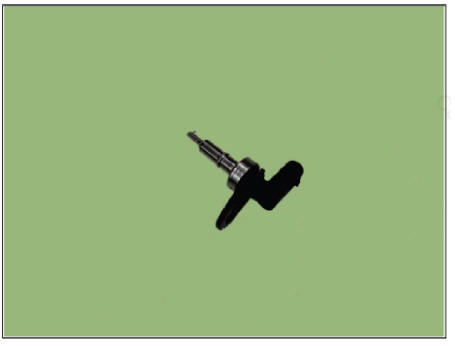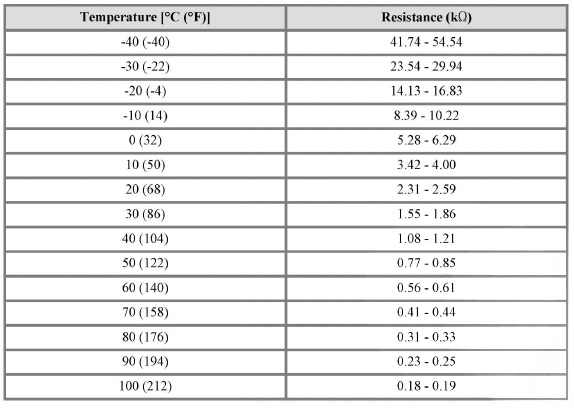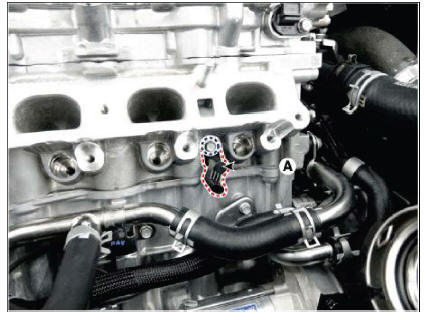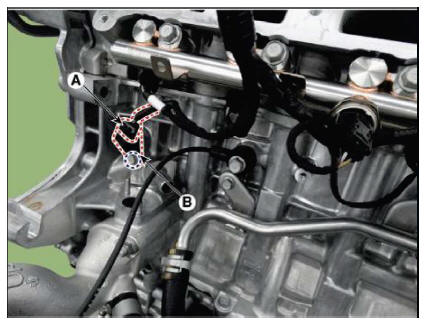Hyundai Tucson: Engine Coolant Temperature Sensor (ECTS)
Description
The Engine Coolant Temperature Sensor (ECTS) is located in the cylinder block and cylinder head, and measures the temperature of the engine coolant. The thermistor of the cooling water temperature and resistance has a negative temperature coefficient (NTC) where the resistance decreases when the temperature rises and the resistance increases when the temperature decreases. The ECTS # 1 mounted on the cylinder head measures the coolant temperature from the engine, and the ECTS # 2 mounted on the cylinder block measures the coolant temperature entering the engine. The ECTS # 1 and the ECTS # 2 deliver the cooling water temperature to the ECM (Engine Control Module), which delivers the signal to the Thermal Management Module valve (TMM). The TMM that receives the signal controls the flow of coolant to adjust the coolant temperature. In addition, the ECTS calibrates the fuel injection quantity and the ignition timing based on the information of the cooling water temperature to prevent the engine failure and an engine-hunting during a cold start test.

Specification

Circuit Diagram

Harness Connector

Inspection
- Turn ignition switch OFF.
- Remove the engine coolant temperature sensor (ECTS).
(Refer to the Engine Coolant Temperature Sensor - "Removal")
- After immersing the thermistor of the sensor into engine coolant, measure resistance between ECTS terminals 1 and 2.
- Check that the resistance is within the specification.
Specification : Refer to "Specification"
Removal
ECTS #1
- Turn ignition switch OFF and disconnect the battery negative (-) terminal.
- Remove the intake manifold.
(Refer to Engine Mechanical System - "Intake Manifold")
- Disconnect the ETC connector.
- Loosen the mounting bolt (A).
Tightening Torque : 9.8 - 11.8 N.m (1.0 - 1.2 kgf.m, 7.2 - 8.7 lb-ft)

ECTS #2
- Turn ignition switch OFF and disconnect the battery negative (-) terminal.
- Remove the MHSG.
(Refer to Engine Electrical System - "Mild Hybrid Starter Generator (MHSG)")
- Disconnect the ECTS connector (A).
- Remove the ECTS after loosening the mounting bolt (B).
Tightening Torque : 9.8 - 11.8 N.m (1.0 - 1.2 kgf.m, 7.2 - 8.7 lb-ft)

Installation
WARNING
- Install the component with the specified torques.
- Note that internal damage may occur when the component is dropped. If the component has been dropped, inspect before installing.
WARNING
Insert the sensor in the installation hole and be careful not to damage.
- Install in the reverse order of removal.
READ NEXT:
 Crankshaft Position Sensor (CKPS)
Crankshaft Position Sensor (CKPS)
Description
Crankshaft Position Sensor (CKPS) detects the crankshaft position and is one
of the most important
sensors of the engine control system. If there is no CKPS signal input, fuel is
not supplied.That is,
vehicle can't run without
 Camshaft Position Sensor (CMPS)
Camshaft Position Sensor (CMPS)
Description
Camshaft Position Sensor (CMPS) is a hall sensor and detects the camshaft
position by using a hall
element.
It is related with Crankshaft Position Sensor (CKPS) and detects the piston
position of each cylinder
which the CKPS can
 Knock Sensor (KS)
Knock Sensor (KS)
Description
Knocking is a phenomenon characterized by undesirable vibration and noise and
can cause engine
damage.
Knock Sensor (KS) is installed on the cylinder block and senses engine knocking.
When knocking
occurs, the vibration from the
SEE MORE:
 Surround View Monitor (SVM)
Surround View Monitor (SVM)
Surround View Monitor can help assist in
parking using the cameras installed on
the vehicle and displays images around
the vehicle through the infotainment
system screen.
Parking Assist View function helps
the driver to see the surround
 Installing a Child Restraint
System (CRS)
Installing a Child Restraint
System (CRS)
WARNING
Before installing your Child Restraint
System always:
Read and follow the instructions
provided by the manufacturer of the
Child Restraint System.
Failure to follow all warnings and
instructions could increase the risk of
the SERIOU
Information
- Home
- Hyundai Tucson - Fourth generation (NX4) - (2020-2023) - Owner's Manual
- Hyundai Tucson - Fourth generation (NX4) - (2020-2023) - Workshop Manual